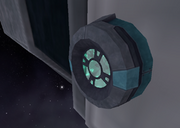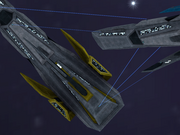CWTOM
From Vendetta Online Wiki

|
Outdated page.
"CWTOM" contains information that is outdated. Please bring the article's information up to date and remove this notice. |
Contents
Introduction
This document is intended to familiarize the crewmembers of the Capital Warship with the various systems and tactics at their disposal.
Ship's Systems (under construction)
Docking Bay
| File:HAC DockingBay.png Click for Full Size |
The capital ships come equiped standard with a single docking bay located on the belly of the ship, at the base of the lower fin. Docking with capital ships is not allowed unless you are "Respected" by that nation. While docked, you can repaired your ship or man one of the turrets still in service. You can not re-arm yourself if you are using ammo based weapons. |
Engines
File:HAC Engine.png
Click for Full Size
File:HAC NAV UI.png
Click for Full Size
Turrets
| Turrets can be manned by docking with the capital ship and selecting one from the menu of available turrets. Only one pilot can control a turret at any givin time. Each turret has an independent life meter, and can receive repairs via nanites as if it were a player controlled ship. Once destroyed though the turrets can not be brought back, even with repair nanites. Currently there are two types of turrets in use, Frigate Gatling Turrets And Beam Cannon Turrets. |
Frigate Gatling Turrets
File:FGT spray.png
Click to Enlarge
Beam Cannon Turrets
Basic Battle Tactics
General Tactics
- Energy weapons will last indefinitely in battle as opposed to conventional weaponry.
- Conventional weapons (Self-propelled rockets and missiles, Mines, Rail-guns, etc.) require the use of ammunition in battle. Theoretically, it will take more direct hits than salvoes you have in your armory in order to destroy another warship.
- Energy weapons only require power from your vessel’s reactor. As long as there is sufficient power, these weapons will be available at a moment’s notice.
- On that note, it should be cautioned that energy weapons should not be fired needlessly nor should a clear and good shot be sacrificed for a possible spray-n-pray maneuver.
- One should never attempt to ram the other warship.
- In your training exercises, this may have been an entertaining way to quickly end a battle, but this is the real world out here. You, no matter your position or job on the ship, are more useful alive than you are dead and a martyr.
- Simulations show that the most damage that could be done to two Serco Battle-Cruisers by colliding with each other at full speed is negligible. Most damage was caused by shearing forces on the ventral pylon and port/starboard winglets.
- If your enemy attempts to make a kamikaze run on your ship, get out of the way. Fire all available weapons at the enemy vessel as you do so, and pray to your chosen Dev that they do not collide with your ship.
Close-Range Engagements (Warship-Warship)
- Always keep moving, unless you have a reason to not be doing so.
- Even if you’re heading in the same or in a similar direction as the enemy warship, by remaining in motion, you make yourself a more difficult target to shoot.
- Another thing to keep in mind is that you should never move in a straight line for more than ten (10) seconds if your enemy is facing you in any direction. Communication is vital between the gunners and the navigator or captain for this to work.
- When attacking, always be aware of the range of your weapons.
- If possible, stay out of your enemy’s range and snipe at them with long-reaching energy weapons or fast-traveling rockets or missiles.
- As you close in on your enemy, fire your weapons sequentially as they come into their individual ranges. Be careful not to overload your reactor, as you will need some energy for the pass-and-retreat.
- If you can avoid it, don’t attack the enemy in head-on runs.
- This will likely cause massive damage to the enemy vessel, but in the process it may cause large amounts of damage to your own ship.
- Your enemy, if they are competent enough to be manning the vessel you face, will know what to do in that situation: evade horizontally or vertically, not accept the attack and sit there.
- If you are attacked in this manner, make an attempt to get out of the way, and instruct your gunners to keep their guns trained on the enemy vessel as it approaches and to fire as it comes into range.
Close-Range Engagements (Warship-Fighter)
- Remember that your vessel is larger and less maneuverable than the fighters.
- Your warship is many times larger and has many times the mass of the smaller fightercraft. Do not bother with trying to outrun fighters that are pursuing or approaching you.
- Much of this mass is made up of armor. Take advantage of this and “absorb†some of your enemy’s attacks; you will be able to retaliate after doing so.
- Use your weapons wisely; do not waste shots in a defensive position.
- Attack ships with appropriately-ranged weaponry. If you have turrets that have ranges of 1km , 800m, and 600m, you should use the 1km turrets for ships about 700m-900m away, the 800m turrets for ships about 550m-750m away, and the 600m turrets for everything below 600m.
- If you can kill something more efficiently with an energy weapon than with a conventional rocket or missile, do so with the energy weapon. It will save you ammunition for when it is truly and desperately required.
- In general, one should concentrate attacks on ships that are actively attacking your offensive and propulsion systems: your turrets and engines.
- Defend against missile- and rocket-toting bombers first, then concentrate on energy-wielding fighter-interceptors.
- Bombers have the highest potential DPP (Damage per Payload) value when loaded with rockets and missiles. While they may be slow, they have armor to compensate.
- Fighter-interceptors have higher maneuverability and top speeds compared to their heavier bomber cousins. When you have dealt with the immediate threats, move on to the further and less pressing enemies.
- When it is difficult to determine the payload or loadout of the ships that are swarming around your hull, start with the ones that are approaching your vessel’s guns. The faster their approach, the faster your weapons will hit their hull, thereby decreasing the enemy pilot’s time to react by sometimes fifty percent or more.
Advanced Battle Tactics
Deep-Space Engagements
- Always know where your enemy is. Never allow the enemy to get behind you if they are facing you.
- Capital warships have abysmal turning rates. Do not underestimate the advantage of being behind your opponent.
- Always try to be where your enemy can't shoot at you.
- If your enemy has a blind spot, be there. If they don't, go where the least number of guns have an ability to track you.
- Remember your Basics.
- Don't ram.
- Attack from outside your enemy's weapon range.
- Keep moving.
Asteroid Field Engagements
- Do not rush.
- Haste will end in disaster if you are not careful.
- Move slowly and carefully around the asteroids. You don't want to get caught on one.
- Use the asteroids for defense.
- Missiles, rockets and lasers all brake for asteroids. Use that to your advantage by using the asteroids as shields.
- Use the asteroids for offense.
- If you know your enemy is flying without flight-assist but you are, incite them to chase you towards an asteroid. Move out of the way at the last possible moment for you. If you're lucky, they will not be able to stop.

